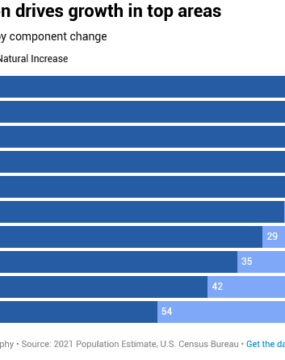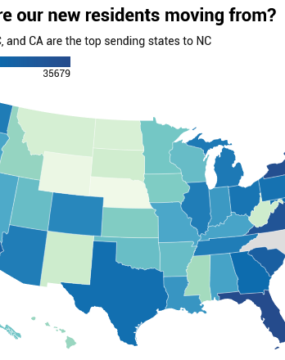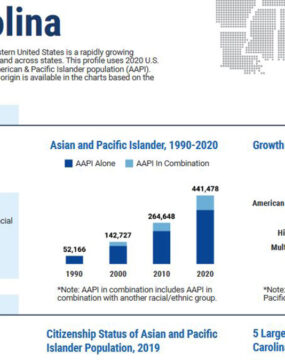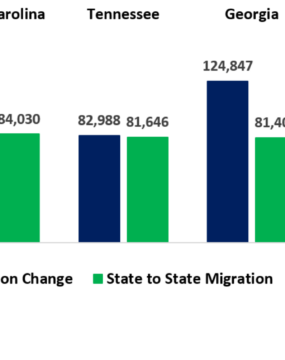Carolina Demographics
Keep up with our latest demographic insights

Nationally, there are 384 metropolitan statistical areas (MSAs), which are defined as economically integrated sets of counties with a core central city with a population of 50,000 or more. MSAs can be located within one state, or they can span across multiple states. They range in size from Carson City, Nevada (58,933) to the New York-Newark-Jersey City MSA (19,768,458) which crosses New York, New Jersey, and Pennsylvania. Within and including North Carolina, there are 17 unique metro regions, ranging from Goldsboro (116,835)…

From 2010 to 2020, North Carolina’s population grew by 9.8% with 49 of our 100 counties increasing in population. Among the largest gains: Charlotte and its suburbs, the Triangle region, and areas from Jacksonville (Onslow County) to Wilmington along the Atlantic Ocean. The map below shows a more detailed view of where we saw the biggest growth and losses amongst Census tracts. A Census tract is a unit of geographic measurement defined by the U.S.…

The majority of North Carolina’s growth over the past few decades has been from net migration, meaning more people moved here than moved away. We last looked at migration to North Carolina in June 2021, and wanted to see how things have changed over the past year. Where are our new residents moving from? Nearly 366,000 individuals moved to North Carolina in 2021, according to the U.S. Census Bureau’s American Community Survey (ACS). Most of those…

What’s behind the dramatic rise in the Southeast’s Asian Indian population? How can data points such as the median age of Asian American groups predict North Carolina’s future? How do the numbers match with growth trends of other populations like Latinx? A UNC Asian American Center collaborative study with Carolina Demography published in November 2022 will help researchers, scholars and communities answer those questions and many more as they plan for North Carolina’s future. The…

Nathan Dollar, PhD, has been named the new director of Carolina Demography, an applied demography center located within the Carolina Population Center at the University of North Carolina at Chapel Hill. Most recently Dollar served as a research scientist and project director for the Dynamics of Extreme Events, People, and Places (DEEPP) survey at the Carolina Population Center, where he investigated the factors that shape how people and communities in eastern North Carolina prepare for,…

Dr. Michael Cline is the state demographer for North Carolina at the Office of State Budget and Management and has given us permission to re-post his content here. Each year, he publishes population estimates and projections for North Carolina and its counties. You may have seen the recent news about the US Census Bureau redefining urban and rural areas. What do these definitions of rural and urban mean for North Carolina? So, what is an…

Dr. Michael Cline is the state demographer for North Carolina at the Office of State Budget and Management and has given us permission to re-post his content here. Each year, he publishes population estimates and projections for North Carolina and its counties. Our latest population projections show that North Carolina will reach 14.0 million people by 2050 – adding 3.5 million people from July 1, 2021 to July 1, 2050 (a 32.7% increase). Here are…

Dr. Michael Cline is the state demographer for North Carolina at the Office of State Budget and Management and has given us permission to re-post his content here. Each year, he publishes population estimates and projections for North Carolina and its counties. This piece was originally published on the OSBM blog. The latest population estimates published by the US Census Bureau show North Carolina’s growth in the past year exceeded the average annual growth during…

On Thursday, the Census Bureau released 2021 population estimates for municipalities. Here’s what the new data tell us about how North Carolina’s cities and towns have changed since the 2020 Census. Winston-Salem passes 250K residents Winston-Salem’s population estimate for July 1, 2021, was 250,320, an increase of 877 or 0.4% since the 2020 Census. The next North Carolina to pass a population milestone may be Wake Forest: at 49,657 residents in 2021 and fast growth…

We recently received a request from a resident in Lincoln County, asking for assistance in locating data related to digital inclusion, in order to help enroll residents who qualify for the FCC Emergency Broadband Benefit. Specifically, the reader asked us to determine the following: How much the acquisition of 200 hot spots in Lincoln County helped close the digital divide How many households in Lincoln County would be eligible for enrollment in the EBB program,…
Your support is critical to our mission of measuring, understanding, and predicting population change and its impact. Donate to Carolina Demography today.